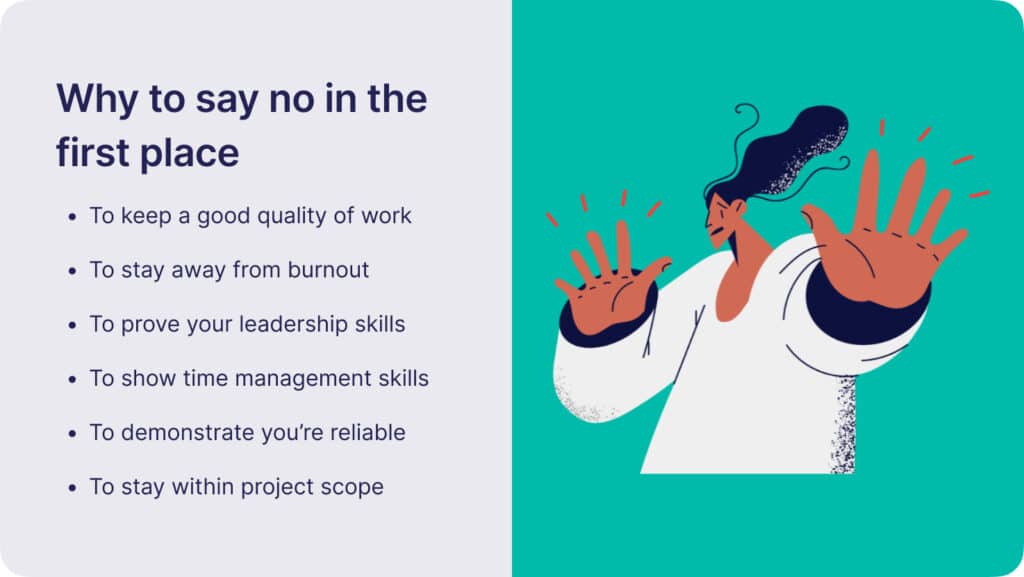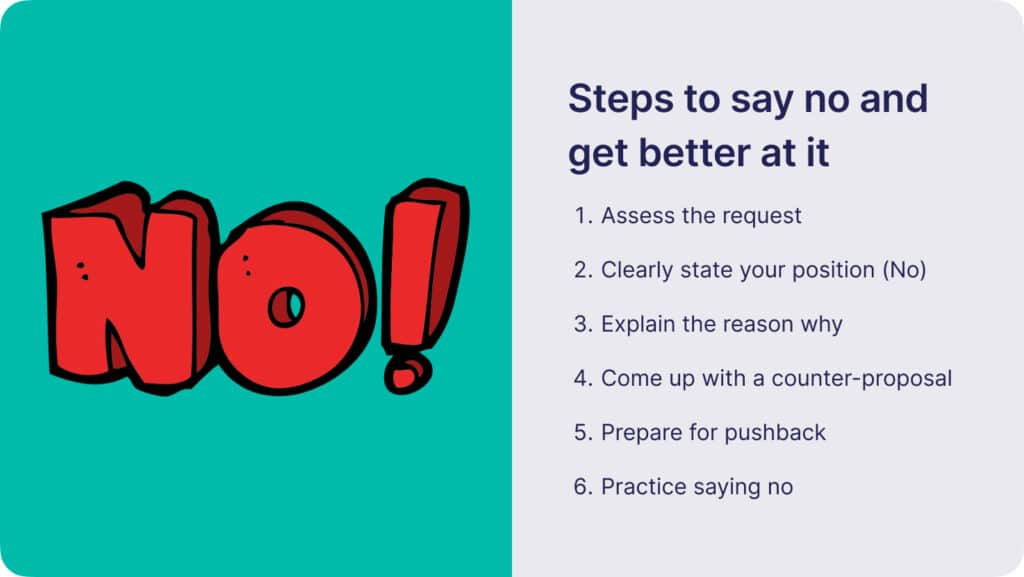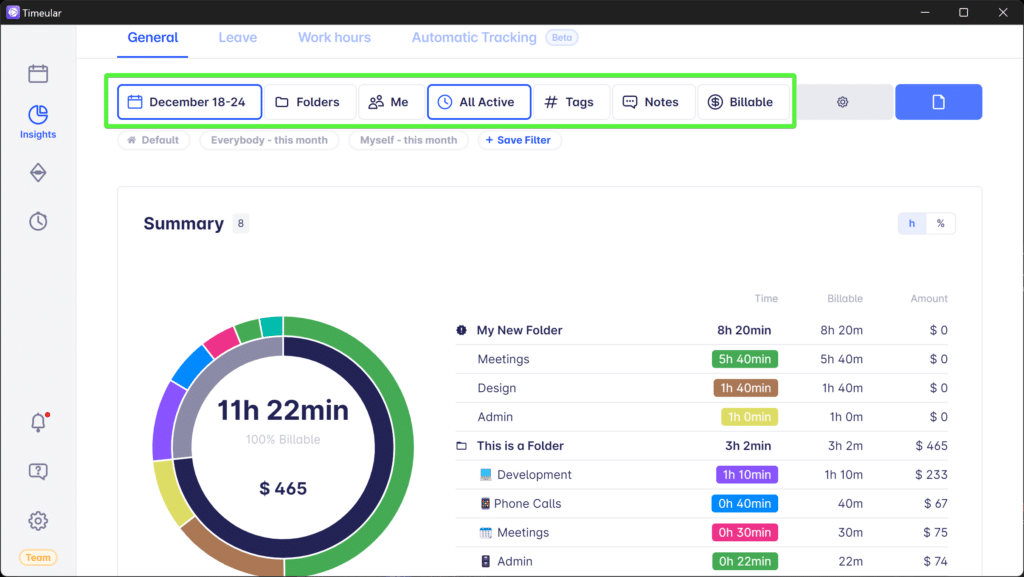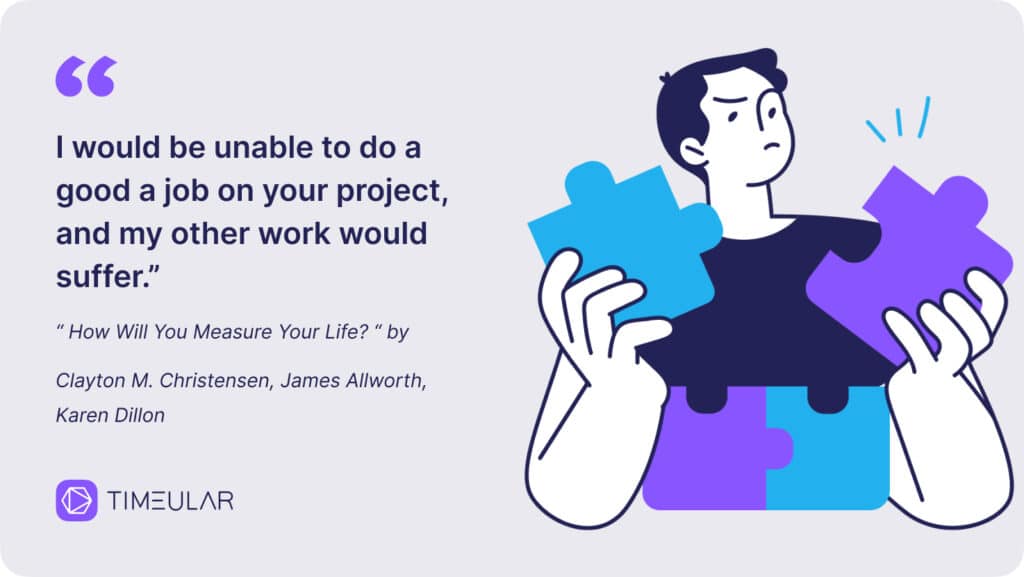Wie man bei der Arbeit Nein sagt [Framework und 6 Beispiele]
Es gibt so viele spannende Projekte, zu denen man "Ja" sagen kann, und so viele Möglichkeiten, sich weiterzuentwickeln, während man gleichzeitig versucht, eine gute Beziehung zu seinen Kollegen oder Managern aufzubauen... Selbst wenn man realistischerweise weiß, dass es keine Bandbreite mehr gibt, um neue Projekte zu übernehmen, ist man viel zu oft die "Ja"-Person.
Dann bereuen Sie es und wünschen sich, Sie hätten das Projekt abgelehnt.
Ich war schon unzählige Male in genau derselben Situation. Deshalb habe ich recherchiert und geübt , wie man bei der Arbeit Nein sagt , und alles, was ich gelernt habe, in diesem Artikel zusammengefasst.
Warum man bei der Arbeit nein sagen sollte

Es ist keine Überraschung, dass es schwierig ist, bei der Arbeit Nein zu sagen. Einigen von uns fällt es schwer, in vielen Situationen Nein zu sagen, ganz zu schweigen von einem beruflichen Umfeld. Aber das hängt mit unserer sozialen Natur als menschliche Wesen zusammen:
"Eines unserer grundlegendsten Bedürfnisse ist das nach sozialer Verbundenheit und dem Gefühl, dazuzugehören. Ein 'Nein' fühlt sich bedrohlich für unsere Beziehungen und dieses Gefühl der Verbundenheit an".
Dr. Vanessa Bohns, Ph.D., und Professorin für Organisationsverhalten an der Cornell University
Machen Sie sich also keine Vorwürfe, weil Sie zu oft "Ja" sagen, sondern verstehen Sie, warum es wichtig ist, bei der Arbeit "Nein" zu sagen. Lassen Sie uns auspacken, warum das wichtig ist:
Aufrechterhaltung einer guten Qualität der Arbeit. Untersuchungen haben gezeigt, dass die wiederholte Ausführung von Aufgaben, die mit Bedrohungen verbunden sind (nicht rechtzeitig fertig zu werden, zu viel Arbeit oder Druck durch Kunden), den Stresspegel erhöht. Wenn Sie also die Arbeit nicht verweigern, werden Sie am Ende versuchen, eine unrealistische Liste von Aufgaben zu bewältigen, was zu einer gehetzten, schlechteren Qualität der Arbeit und einer geringeren Produktivität führt.
- Damit Sie gesund bleiben und nicht ausbrennen. Was wie ein Modewort anmuten mag (da jeder darüber zu sprechen scheint), ist ein erwiesener Zusammenhang zwischen Burnout und einer hohen Arbeitsbelastung oder langen Arbeitszeiten, neben anderen Faktoren. Wenn Sie nicht lernen, zu mehr Arbeit Nein zu sagen, werden sich zu viele Aufgaben in Ihre Liste einschleichen, und Sie können gefährdet sein.
- In einer Umfrage von McKinsey Health aus dem Jahr 2022 unter 15.000 Arbeitnehmern in 15 Ländern wurde festgestellt, dass ein Viertel der Arbeitnehmer unter Burnout-Symptomen leidet, die auf zu viel Arbeit zurückzuführen sind.
Um Ihre Führungsqualitäten und Ihr Zeitmanagement unter Beweis zu stellen Zeitmanagement-Fähigkeiten. Auch wenn es kontraintuitiv ist, wenn Sie klar kommunizieren, dass Sie nicht in der Lage sind, neue Aufgaben zu übernehmen, und ehrlich über die zeitlichen Beschränkungen sprechen, werden Ihre Kollegen verstehen, dass Sie es gut verstehen, Prioritäten zu setzen und sich durchzusetzen.
Um zu zeigen, dass Sie zuverlässig sind: Wenn Sie Nein sagen, schaffen Sie Vertrauen bei Ihrem Chef, Ihren Mitarbeitern und anderen Beteiligten. Sie zeigen, dass Sie organisiert sind; Sie wissen, wann Sie eine neue Arbeit annehmen und zu Ende bringen müssen.
Innerhalb des Projektumfangs bleiben: Wenn Sie sich auf eine Frist geeinigt haben, können Sie diese nicht überschreiten oder in letzter Minute neue Aufgaben übernehmen.
Wie man bei der Arbeit Nein sagt - in 6 Schritten

1. Bewerte den Antrag
Wenn Sie diese überwältigende Nachricht erhalten, geben Sie sich, auch wenn Sie sich unwohl fühlen, etwas Zeit, um die Anfrage zu analysieren. Lehnen Sie das zusätzliche Projekt nicht sofort ab. Führen Sie eine kurze Zeitprüfung durch, um herauszufinden, wie viel Arbeit Sie haben und ob Sie andere Aufgaben übernehmen können.
Stellen Sie anschließend Fragen, um den Umfang und die Bedeutung des Projekts/der Aufgabe zu bewerten, und stellen Sie sich auch die folgenden Fragen:
Ist es ein Projekt, an dem Sie sich gerne beteiligen würden?
Erregt es Sie oder trägt es zu Ihrem Wachstum bei?
Wenn ja, könnten Sie sich innerhalb des erforderlichen Zeitrahmens dafür einsetzen?
Sind Sie geistig in der Lage, das zu bewältigen?
Wird es Ihre Produktivität bei anderen Projekten gefährden?
Eine Frage, die die Dinge ins rechte Licht rückt, lautet: Wie viel wird Ihr "Nein" die andere Person kosten? ("Wie werden Sie Ihr Leben messen?").
Wenn Sie sich nicht sicher sind, wie viel Kapazität Sie haben werden, kann die Zusammenfassung aller Arbeiten an einem zentralen Ort Ihnen helfen, diese schnell zu visualisieren und Ihre Arbeitsbelastung leicht zu verstehen.
Eine App zur Zeiterfassung kann Ihnen dabei helfen, Ihr aktuelles Arbeitspensum zu verstehen und mit den anderen Teammitgliedern oder Managern zu teilen und objektiv aufzuzeigen, wie Sie Ihre Zeit verbringen. Dies ist ein Beispiel für einen Bericht von Timeular:

2. Erkläre klar deinen Standpunkt (Ablehnung)
Wenn Sie alle erforderlichen Daten gesammelt haben und feststellen, dass Sie keine Bandbreite für diese neue Aufgabe haben, keine Begeisterung und keine Opportunitätskosten, lehnen Sie höflich ab.
Wenn Sie ein natürlicher Menschenfreund sind, ist dies der schwierigste Teil für Sie. Sie wollen nicht als unkooperativ oder nicht teamfähig gelten. Ja, Sie könnten sich auch schlecht fühlen, wenn Sie Nein sagen.
Bleiben Sie dran. Als Nächstes werden Sie lernen, wie Sie Grenzen setzen und ehrlich über Ihr Arbeitspensum sprechen können, ohne die Tür zu verschließen.
3. Erkläre den Grund, warum
Es ist wichtig, Ihrer Ablehnung einen Hintergrund zu geben. Auf diese Weise können Ihr Chef oder Ihre Kollegen nicht davon ausgehen, dass Sie kein Teamplayer sind oder zu den Mitarbeitern gehören, die eine Herausforderung nicht annehmen, weil sie nicht in der Stellenbeschreibung steht. Der beste Weg, einen Streit zu entschärfen, besteht darin, klar und kurz zu erklären, warum Sie die Aufgabe nicht übernehmen können. Nennen Sie klar und deutlich den wahren Grund, warum Sie die Anfrage ablehnen müssen.
Verwenden Sie keine selbstabwertenden Erklärungen - diese sind leicht zu bekämpfen und können unwahr wirken. Sie könnten sagen, was Sie zu tun haben, welche Fristen Sie haben und warum die zusätzliche Arbeit nicht von Vorteil ist.
In dem oben zitierten Buch wird auch vorgeschlagen, dem Gesprächspartner den Nachteil zu verdeutlichen, den er erleiden würde, wenn Sie sich zu sehr engagieren würden:

Gut zu wissen... Sagen Sie Nein, indem Sie positive Verstärkung einsetzen (denken Sie daran, dass sie aus einem bestimmten Grund an Sie gedacht haben, entweder weil sie erfahren sind oder weil sie wissen, dass Sie Projekte superschnell ausführen), also sollten Sie sie nicht davon abhalten, in Zukunft an Sie zu denken.
Ein gutes Beispiel ist: "Danke, dass Sie an mich gedacht haben! Sie sind unglaublich gut darin, nach Möglichkeiten zu suchen und die richtigen Leute zu finden. Sie können sich gerne ein anderes Mal bei mir melden, der Zeitpunkt könnte richtig sein. "
4. Erarbeiten Sie einen Gegenvorschlag
Denken Sie daran, dass Sie Ihr Nein neu formulieren können. Wenn Sie z. B. zu dem Schluss kommen, dass Sie die Person sind, die in dem Projekt gebraucht wird (= der einzige Designer im Team, der einzige Projektleiter usw.), müssen Sie diese Aufgabe schließlich übernehmen.
Die Art und Weise, wie Sie hier Grenzen setzen, kann also sein:
Verteilen Sie die Prioritäten auf Ihrer Aufgabenliste so, dass Sie den Termin einhalten können;
Verhandeln Sie mit Ihrem Vorgesetzten einige Fristen und sogar die Frist des Gegenübers, der Sie mit der Aufgabe betraut hat;
Weisen Sie darauf hin, dass eine bessere Lösung für sie darin besteht, eine andere Person zu wählen, die diese Aufgabe übernehmen kann oder sogar besser qualifiziert ist als Sie für diese Aufgabe;
Bieten Sie an, bei dem Projekt oder der Aufgabe zu helfen, aber nicht, indem Sie sich ständig aktiv beteiligen (z. B. indem Sie Feedback zu den Entwürfen geben, einen Leitfaden weitergeben oder als Ansprechpartner dienen, wenn es Blockaden gibt);
Wenn Sie einmal "Nein" gesagt haben, wäre es ideal, wenn man Sie nicht den ganzen Tag am Wasserspender des Arbeitsplatzes sieht, denn das könnte zeigen, dass Sie keinen guten Grund hatten, "Nein" zu sagen.
Erfasse die Zeit automatisch oder manuell, mit einem physischen Zeiterfassungsgerät oder mit Tastaturkürzeln. Weniger als 1 Minute pro Tag.
5. Auf Pushback vorbereiten
Natürlich wird sich jemand wehren, wenn er davon überzeugt ist, dass Sie derjenige sind, der ihm helfen sollte. Also müssen Sie genau in diesem Moment die Stellung halten.
Alle Diagramme und Tools zeigen an, wie viel Sie zu tun haben, so dass Sie buchstäblich keine Zeit mehr haben, sich zu sehr zu verausgaben.
Die Lösung? Bleiben Sie konsequent bei Ihrem Nein.
Ihr Kunde oder Ihre Mitarbeiter können Ihre Reaktion falsch verstehen und sogar negative Rückmeldungen geben. Nichtsdestotrotz ist es richtig, dass Sie es nicht allen recht machen können, geschweige denn ihre Reaktion kontrollieren können, aber Sie können sie beeinflussen.
Ihre Reaktion auf Ihr "Nein" können Sie ganz einfach beeinflussen:
- Danken Sie ihnen, dass sie Ihnen die Möglichkeit geben
- klar zu erklären, warum ihre Aufgabe andere Arbeiten von Ihnen beeinträchtigt
- Die Tür offen lassen, indem man eine Alternative anbietet.
6. Nein sagen üben
In dem Buch "How Will You Measure Your Life" (Wie werden Sie Ihr Leben messen?) schlagen die Autoren vor, das Nein-Sagen zu üben , so wie man eine Fertigkeit üben würde (verstehen Sie mich nicht falsch, Nein-Sagen ist wirklich eine Fertigkeit).
Üben Sie, es laut zu sagen, allein, mit Kollegen oder mit jemandem, der Sie unterstützen möchte. Wenn Sie damit zu kämpfen haben, Gelegenheiten abzulehnen oder einfach nur Nein zu sagen, werden Sie, wenn Sie nicht üben, zu einem Ja-Sager werden, ohne es zu merken.
Wenn Sie also eine Zeit lang tagein, tag aus üben, wird es Ihnen schließlich leichter fallen, mehr Arbeit anzunehmen. Der beste Teil dieses Prozesses besteht darin, "auf sich selbst zu hören" , während Sie dieses Bedürfnis äußern. In kürzester Zeit werden Sie feststellen, dass das Ablehnen von Aufträgen nicht mehr zu den schrecklichsten Aufgaben auf der Liste gehört.
Sie schämen sich nicht und entschuldigen sich auch nicht in Nachrichten. Sie werden entschlossen, klar und diplomatisch antworten.
Beispiele dafür, wie man am Arbeitsplatz Nein sagen kann
Wie man Nein zu seinem Chef sagt
Sie stimmen wahrscheinlich zu, dass es am schwierigsten sein kann, Ihrem Chef gegenüber Nein zu sagen. Das ist zu erwarten, aber denken Sie einfach an Folgendes, wenn Sie Ihrem Chef Nein sagen:
Ihr Chef weiß vielleicht nicht alles, woran Sie arbeiten -> Wenn Sie die Anfrage erhalten, antworten Sie, indem Sie Ihre Arbeitsbelastung sichtbar machen
Nachfassen mit Fragen zur Klarstellung
Scheuen Sie sich nicht, über die Frist zu verhandeln , wenn der Antrag in letzter Minute eingereicht wurde.
Mögliche Antwort:
" Hallo (Name),
Dieses Projekt scheint spannend zu sein! Im Moment (= diese ganze Woche) konzentriere ich mich auf die Fertigstellung des Projekts für Kunde A, das am Freitag abgeschlossen sein muss.
Ich würde aber gerne danach an diesem Projekt arbeiten. Ist das etwas, das funktionieren könnte? Wenn ja, lassen Sie uns am Freitag zusammenkommen, um einen neuen Termin festzulegen.
Wie man Nein zu seinen Mitarbeitern sagt
Es ist auch nicht leicht, Nein zu seinen Mitarbeitern zu sagen. Eine gute Beziehung zu den Kollegen ist von großem Vorteil. Sie können sich gegenseitig unterstützen, um Fachwissen zu erwerben, oder sie können sogar Ihre Freunde sein.
Wenn Sie lernen, Grenzen zu setzen, sanft Nein zu sagen und Alternativen anzubieten, wird Ihre Beziehung sicher sein.
Mögliche Antwort:
" Hallo (Name)!
Ich würde gerne dabei helfen, da ich weiß, wie wichtig dieses Projekt für Sie ist. Ich fürchte, mein Kalender ist bis Freitag vollgepackt.
Ist es möglich, sich am Freitag gleich in der Früh zu treffen? Wenn ich ein paar schnelle Vorschläge machen kann, bin ich gerne zu einer 10-minütigen Besprechung bereit. "
Wie man Nein zu seinem Kunden sagt
Viele Unternehmen verfolgen einen kundenorientierten Ansatz, was großartig ist, aber wie können Sie einem Kunden absagen, wenn er darauf drängt, dass Sie kurzfristig eine neue Aufgabe übernehmen?
Die Chance ist groß, und man ist versucht, zu allem Ja zu sagen, vor allem als Teil eines Start-ups und einer Agentur.
" Hallo (Name),
Ihre neue Kampagnenidee klingt großartig. Ich habe jedoch gerade unseren Terminkalender überprüft und befürchte, dass eine Fertigstellung in der nächsten Woche aus zwei Gründen nicht machbar ist:
In der Regel benötigen wir für ein solches Projekt 2 Wochen vom Konzept bis zur Umsetzung;
Wenn wir Ihre Kampagne jetzt überstürzen, erweisen wir Ihnen einen schlechten Dienst, wenn wir sie innerhalb des von Ihnen gewünschten Zeitrahmens durchführen.
Wir wollen wirklich, dass alle unsere Kundenprojekte erfolgreich sind, deshalb würde ich vorschlagen, den Termin in zwei Wochen zu überdenken. Wir rufen Sie gerne an, um die Schritte zu erklären und gemeinsam eine Lösung zu finden.
Teilen Sie mir Ihre Meinung mit, "
Danke, dass du an mich gedacht hast, aber nein
Nein-Sagen am Arbeitsplatz zu lernen , erfordert Übung und ist nicht von Anfang an einfach. Dieses Gerüst und die Beispiele sollten Sie in der Tasche haben, wenn Sie gebeten werden, eine neue Aufgabe zu übernehmen.
Denken Sie daran: Bessere Grenzen und bessere Leistungen am Arbeitsplatz beginnen, wenn Sie sich entscheiden, Nein zu sagen.
Bonus: Bei der Recherche zu diesem Artikel habe ich ein interessantes Video der Harvard Business Review zu diesem Thema gesehen:
HÄUFIG GESTELLTE FRAGEN
Ist es überhaupt in Ordnung, am Arbeitsplatz Nein zu sagen?
Ja, auf jeden Fall!
Wie bereits erwähnt, gibt es zahlreiche negative Auswirkungen, wenn man zu oft Ja sagt. Lassen Sie mich mein Beispiel erzählen:
Als Autorin recherchiere ich täglich, was die Leser lernen müssen und was sie wissen wollen, ich interviewe und spreche mit unserem Team, um ihr gesamtes Fachwissen herauszuholen und es mit Ihnen zu teilen, ich lese Forschungsarbeiten, plane eine E-Mail-Kampagne und beschäftige mich eingehend mit jedem Detail des Blogs, der Bildsprache usw.
Und das ist noch nicht alles.
Aber... Wenn ich zu allem Ja gesagt hätte, wären meine Hauptaufgaben gefährdet gewesen. Es macht mir nichts aus, zusätzliche Aufgaben zu übernehmen, vor allem um zum Wachstum und zur Vision unserer Organisation beizutragen. Aber hin und wieder muss ich auch Nein sagen, wenn mir eine Arbeit spannend erscheint oder mich weiterbringt.
Ich habe einfach nicht genug geistige Kapazität, um ein anderes Projekt zu übernehmen oder Zeit, um es zum Glänzen zu bringen. Dann ist es besser, es abzulehnen.
Wie kann ich Nein sagen, ohne mich schuldig zu fühlen?
Wenn Sie den oben vorgestellten Rahmen erst einmal praktizieren, werden Sie feststellen, dass es keine Nachteile oder wirklich negativen Auswirkungen auf Sie selbst oder auf die Sicherheit Ihrer Arbeit gibt. Ich muss noch erwähnen, dass Sie sich der Toxizität des Arbeitsumfelds, in dem Sie sich befinden, bewusst sein müssen. Alle Ratschläge, die hier gegeben werden, gelten nicht unbedingt für ein toxisches Umfeld.